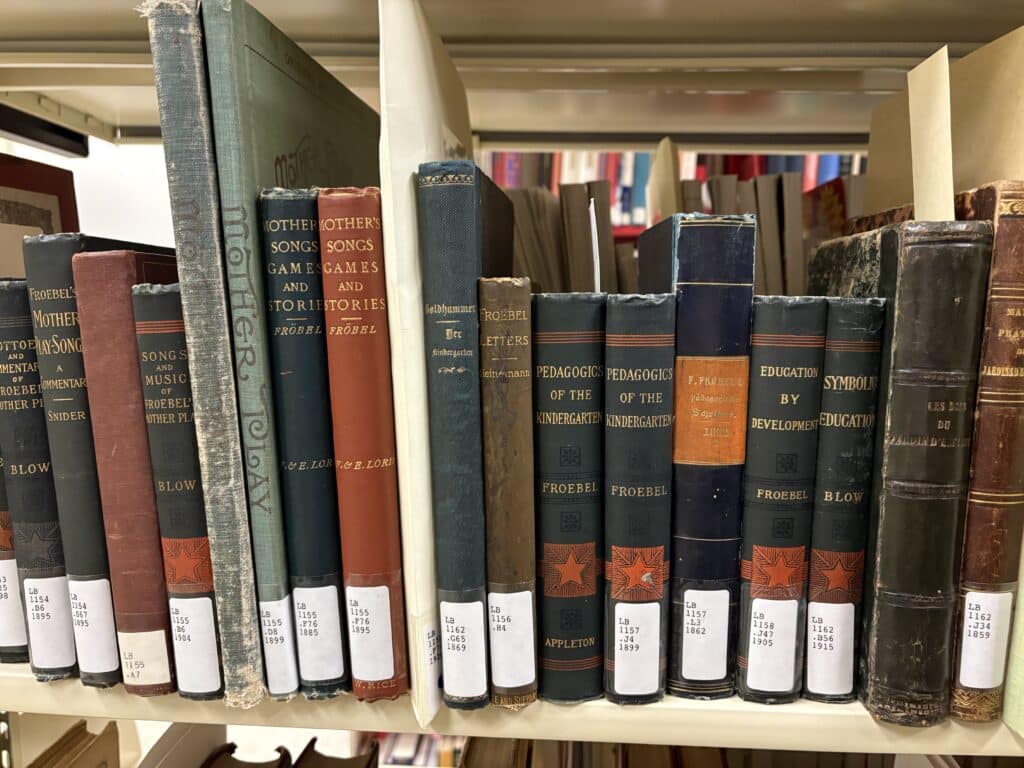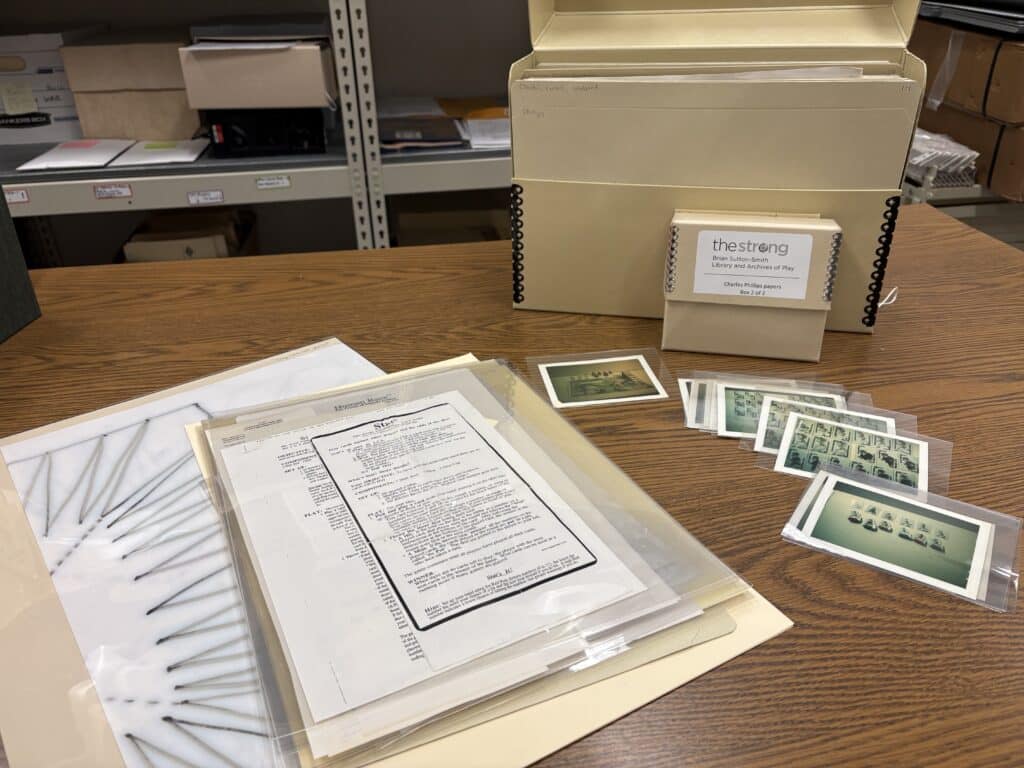The Brian Sutton-Smith Library and Archives of Play sits quietly on the third floor of The Strong above the excitement and joy of our museum guests. Most guests don’t realize that this library even exists or that it is one of the largest study collections on play in the world. The library collection is one central element to the museum’s mission to share the history and many meanings of play. The library helps the staff as they consider new exhibitions, research new forms of play, and documents historical context for the museum’s extensive object collections of games, puzzles, and toys. It collects both published and unpublished materials (referred to as archives) that document the development, production, sales, culture, and history of all types of playthings and fun activities from dolls to video games. The size of the collection is large and continues to grow. For those folks who like nerdy statistics, the library has more than 255,000 published books and magazines and 2,415 linear feet of archives (that is more than the length of 24 football fields long!).

You might be wondering what IS all this stuff? And where did it come from? The curators and the library team work to identify materials for purchase, but the time and resources to find and purchase such collections are limited. The real gold frequently comes from donations both large and small. Through these donations, the enormous range and depth of play becomes apparent. One recent example of a large donation has been the corporate records of a video game company. Other recent examples include the product designs by creative professionals working on dolls and playground equipment, scholarly research on animal play, and interviews with video game creators and executives. Smaller collections commonly come from devoted collectors focused on a particular toy or game or form of play. Puzzles and puzzle-making, 19th-century kindergarten materials, competitive Scrabble, the logic of checkers, and 500 titles from one specific children’s book publisher are all topics of collections that have come to the museum through donations lately. In the process of answering reference questions, the library team sometimes discovers that we hold the only copy in any library in the United States or the world.
All these companies and individuals were motivated to donate their material by a very simple idea. Each wanted to ensure that their work, objects, and ideas would not be destroyed. Each wanted to share their passions and continue to be useful. Through the work of a dedicated team of professional historians, curators, archivists, and librarians, The Strong provides a haven to both preserve these essential resources and make them available for others to explore. This team is knowledgeable on the care of paper, digital, and recording media formats to protect the materials for future generations. Before any of that can happen, each donation started with a simple conversation or email to the library or one of museum’s curators asking the question, “Might the museum be interested in my materials?”
That simple question initiates a conversation about the volume of materials, physical condition, and subject(s) or topics covered. Central to this conversation for The Strong’s team is whether the collection might be helpful for researchers or exhibits, appropriate for the museum’s play-related mission, and whether any condition or storage issues may present a challenge. The Strong team askes potential donors to think about the collection. Questions might include:
– Are these materials about a particular topic or an organization?
– What is the general condition of the materials? Where have they been stored?
– What is the total amount of all the materials together?
– Could you send us a few pictures of the materials to help describe the collection?
The other side of this conservation from the potential donor perspective, frequently include:
– Is this the appropriate place to put my collection?
– Will my materials be used or simply sit on a shelf?
– Will you scan everything?
– How do I send it all to you?
This discussion is an important step—the museum does not accept unsolicited donations—and will be the difference between possible accepting the gift or politely declining it. Accepting the donation is a promise to the donor AND an obligation for the museum. That promise is not taken lightly and requires a good amount of thought for both sides of the conversation before further commitment.
If both the library team and the potential donor agree, the next step is the transfer of materials to the museum. Smaller collections arrive via FedEx or postal shipments while larger ones may involve whole tractor trailers. How donations arrive at the museum depends on the number of materials and how fragile they might be. Many donors pack and ship to the museum. Sometimes with larger and more fragile collections, a team from the museum may assist with the move or contract with a third party to pack and ship items to Rochester.
The library team then unpacks the materials and begins the process of documenting the collection in detail and formally transferring ownership to the museum. Accessioning is the museum term for the formal acceptance of ownership by The Strong. A critical part of the accessioning process is documenting exactly what we received. Since few collections arrive with a complete inventory, an initial sorting is invaluable. If the collection is large, a good amount of time (weeks, months, or even years) might be needed for this step. Then the detailed collection inventory is put forth for review and approval by the Strong’s Acquisitions team composed of representatives of the curatorial, interpretation, and administrative staff. After approval by the Acquisitions team, the donor will receive a Deed of Gift to sign. The Deed of Gift acknowledges what our initial sorting revealed and transfers legal ownership to the museum.

More detailed work for the museum team begins after accessioning. The library and archives staff begin to formalize descriptive detail about the collection and enter this detail in the appropriate collection database. The staff document the format, subject matter, and other details according to professional standards set by the American Library Association, Society of American Archivists, and by The Strong Museum staff itself. Part of this process might be to re-folder and re-box everything to make the items safe to move and handle. For digital data, the archives team follows a specific set of protocols as defined in The Strong’s Digital Preservation Manual to ensure the data is preserved and secure while being accessible for research.
For archives, the result of this work is something called a finding aid. A finding aid is a document that helps researchers understand what the materials are, what subjects are covered, who donated them, any potential restrictions, and then lists the files found in each container. For collections of books or published materials, the library team describes each volume in detail, including title, author, subject matter and shares that data with other libraries via a global resource for libraries called WorldCat, a special book-related database from tens of thousands of libraries. Anyone in the world can see if we have a particular book! Because of the type of materials The Strong collects, frequently we might be the only library in North America or the world to own it. It is common for library staff to receive emails or phone calls from all over the United States, Europe, or Asia about our unique holdings.
As this rigorous cataloging is completed, the results are searchable in the appropriate databases, also called catalogs. Researchers interested in using the library use these catalogs to discover what items might be helpful. The last step for especially exciting donations is The Strong issues press releases and social media posts to alert potential researchers about newly cataloged materials. If you are curious here a link to
On-site access to the full museum collection is available to scholars, students, collectors, and other researchers by appointment. Appointments may be made via an online form, by phone at 585-410-6349, or by sending an email to library@museumofplay.org. The library is open Monday-Friday, 9am-4pm (except holidays) and advance notice of at least two weeks is required. The relative quiet of the library, however, doesn’t easily reveal the importance of this collection beyond the museum building. The library team answered more than 500 requests for during 2024—in person and via email. These requests came from all over the United States and around the globe (Argentina, Australia, Hong Kong, Japan, and the United Kingdom, for example).
If you have collections of books or papers related to play and are looking for a new home for them, please email or call to start a conversation!
By: David Sleasman, Senior Director of Libraries and Archives


